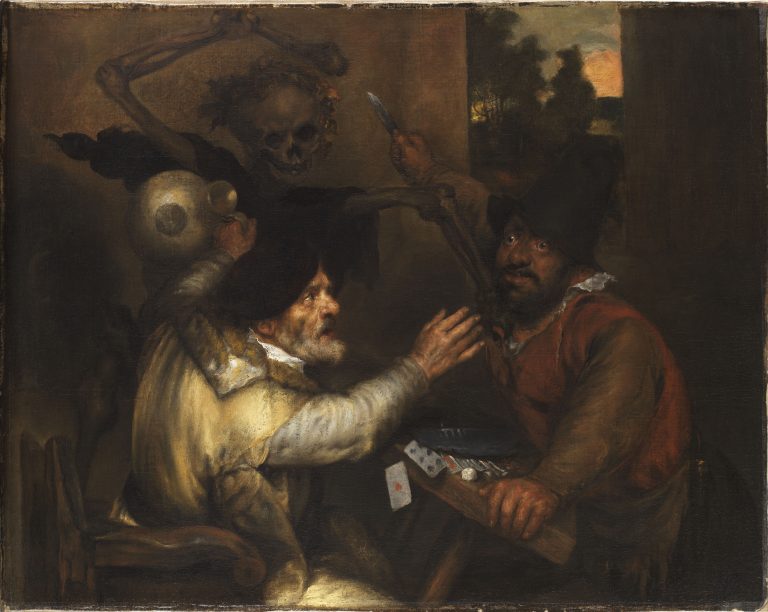In 1635 Jan Lievens moved from London to Antwerp, perhaps expecting that the arrival of the new governor-general of the Southern Netherlands, the Cardinal-Infante Ferdinand, would usher in a period of peace and prosperity beneficial to the arts.1 Lievens soon joined the local painters’ guild and settled into a community of artists who specialized in low-life genre scenes, landscapes, and still lifes, among them Adriaen Brouwer (1605/6–38), Jan Davide de Heem (1606–83/84), David Teniers the Younger (1610–90), and Jan Cossiers (1600–71). In 1635, Brouwer depicted these artists in a tavern scene, Smokers, in the Metropolitan Museum of Art (fig 1).2 The most inspirational of them for Lievens was Brouwer, who apparently encouraged Lievens to depict, once again, rough peasant types comparable to those he had portrayed in genre scenes at the beginning of his career (fig 2).
Brouwer’s impact on Lievens is particularly evident in two fascinating genre paintings of peasants confronting death that he executed in 1638, Fighting Card Players and Death in The Leiden Collection and Greedy Couple Surprised by Death (fig 3). Lievens’s paintings, seemingly pendants because they are comparable in size and visually and thematically related, capture the struggle for survival that Brouwer often depicted in his genre images of rough-hewn peasants battling each other in inns and taverns. The brawls that Brouwer depicted, however, are of a different order, for they do not feature, as did Lievens, Death in the guise of an animated skeleton attacking his frightened adversaries.
In Fighting Card Players and Death, Death has fully engaged in the battle for human survival transpiring between an enraged white-bearded card player who brandishes a beer tankard and his knife-wielding opponent. With a vine wreath wrapped around his skull, Death gleefully grabs the latter’s red tunic and prepares to club him with a thigh bone. The bulging eyes and pale complexion of the younger player as the card table falls onto his lap, scattering the cards and the slate on which the score has been tallied, indicate that he is all too aware of his bleak fate. Through the open doorway of this darkened interior, one sees a landscape with the setting sun, suggestive of the inevitability of death.3 In Greedy Couple Surprised by Death, the skeletal figure of Death interrupts an elderly couple in the midst of counting a hoard of money. As the old man tightly clasps their bag of coins, the old woman’s wide-eyed expression registers her shock at Death’s unwelcome arrival as she desperately tries to push him away. The clock behind them, however, warns that the moment of reckoning has come. With a leering smile and head cocked at an angle, Death almost seems to mock them, enjoying his ghoulish task.
Both these paintings draw their subjects from a well-established iconographic tradition in Netherlandish art: death can come for anyone at any time. This theme appears in Pieter Bruegel the Elder’s Triumph of Death, ca. 1561 (Museo del Prado, Madrid), in which the skeletal dead rise en masse from their graves to snatch the living from the bustle of daily activities. In addition, Peter Paul Rubens’s earliest known drawings are copies after woodcuts from Hans Holbein the Younger’s Dance of Death series, published in 1562. Rubens copied all 49 scenes, which show Death appearing to the unsuspecting in the midst of everyday life, including a scene of a skeleton snatching coins from a miser’s table.4
While themes related to life’s brevity and the elusiveness of worldly possessions also occur in seventeenth-century Dutch and Flemish painting, they primarily appear in portraits or vanitas still lifes containing such motifs as an extinguished candle, hourglass, or skull. The jarring appearance of an animated and predatory Death was far less common, and indicates the strong moralizing quality that Lievens sought to instill in these works, a theme expressly evident in the inscription added below a reproductive etching Lievens made of Fighting Card Players and Death (fig 4). The inscription reads: “The ancient serpent hastens to spread quarrels and hatred, but death cancels all brawls.” 5
Lievens’s paintings Greedy Couple Surprised by Death and Fighting Card Players and Death, as well as the print he made after the latter work, all date to 1638. Lievens undoubtedly created these works in that year in response to the devastating plague then ravaging the Netherlands, a plague that claimed the life of, among others, Adriaen Brouwer. The realization that death could come at unexpected moments was one that must have weighed heavily on the populace, and Lievens, as well as other Dutch and Flemish artists, responded in imaginative and compelling ways to this mortal reality.6
